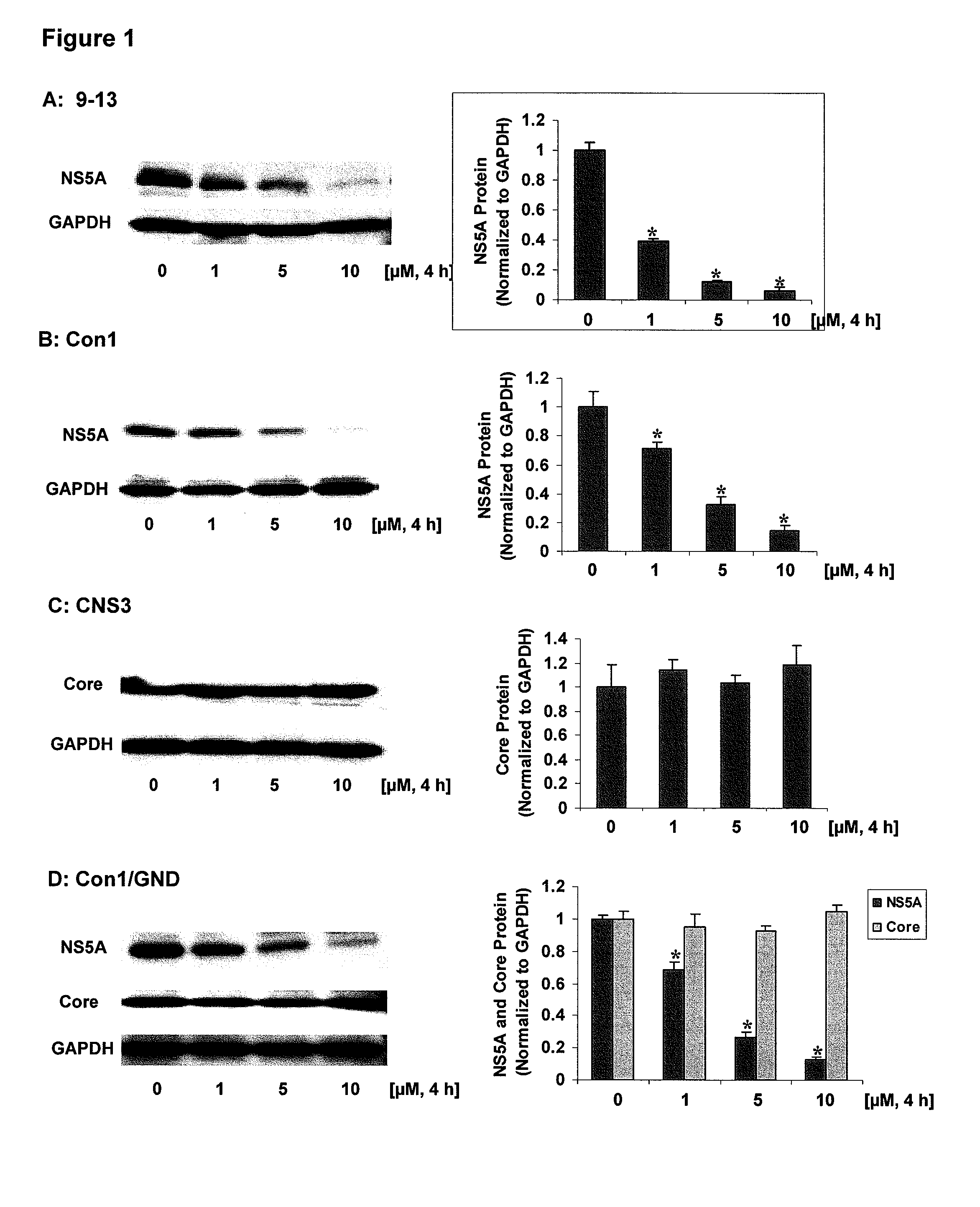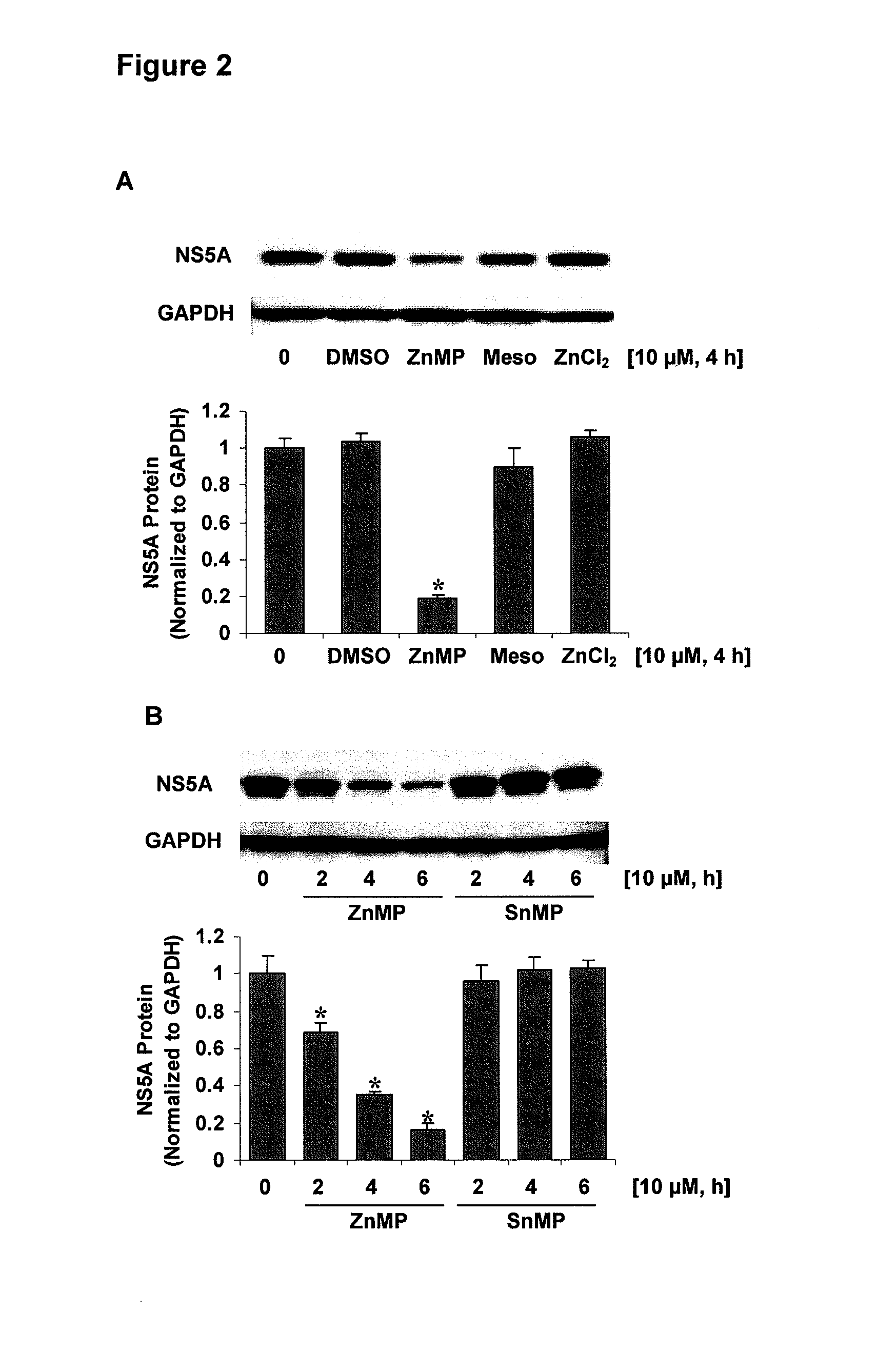Treatment of Hepatitis C Infection With Metalloporphyrins
a technology of metalloporphyrin and hepatitis c infection, which is applied in the field of treatment of hepatitis c infection, can solve the problems of inability to produce sustained virological response in as many as 46% of treated persons, unfavorable treatment effect, and high cost of current treatments based on the combination of pegylated interferon alpha ribavirin, so as to reduce the level of ns5a cells, significantly suppress
- Summary
- Abstract
- Description
- Claims
- Application Information
AI Technical Summary
Benefits of technology
Problems solved by technology
Method used
Image
Examples
example 1
[0101]In this example, the down-regulation of HCV proteins by ZnMP was investigated. NS5A protein levels in 9-13 and Con1 cells, core protein levels in CNS3 cells, and NS5A and core protein levels in Huh-7 / T7 cells transfected with pFK-Con1 / GND (a plasmid encoding a replication deficient variant of Con1) exposed to different concentrations of ZnMP (0, 1, 5, 10 μM) for 4 hours were evaluated. After treatment, the cells were harvested and the total protein was isolated. Proteins were separated on 4-15% SDS-polyacrylamide gel, transferred to a PVDF membrane, and probed with anti-HCV NS5A, anti-HCV core or GAPDH specific antibodies, bands corresponding to NS5A, core or GAPDH were detected by the ECL-Plus chemiluminescence as described above. In the Figs., the amounts of NS5A or core protein levels were normalized to GAPDH which did not vary with treatment. Values for cells treated with vehicle only were set equal to 1. Data are presented as means±SE from triplicate samples. * differs fr...
example 2
[0105]In Example 2, effect of zinc chelator, N, N, N, N-tetrakis-(2-pyridylmethyl) ethylenediamine (TEPN) on NS5A protein levels was investigated. 9-13 cells were treated with indicated concentrations of TEPN 30 min before ZnMP treatment, the cells were subsequently exposed to ZnMP or to vehicle (DMSO) alone as control for 4 h. Total proteins were extracted. NS5A and GAPDH protein levels were measured by Western blot. The bar graphs show quantitative results. The relative amounts of NS5A protein were normalized to those for GAPDH, which did not vary with treatment. The band intensity of NS5A from vehicle alone was set equal to 1. * differs from vehicle only, P<0.05. As shown in FIG. 3, zinc chelator TEPN did not affect ZnMP-mediated profound down-regulation of NS5A protein levels in 9-13 cells.
example 3
[0106]In Example 3, the down-regulation of NS5A protein by ZnMP was investigated to determine whether the down-regulation occurs at a post-translational level. 9-13 cells were treated with 100 ug / mL cycloheximide (CHX) and with or without 10 μM ZnMP for the indicated periods (0, 0.5, 1, 2, 4 h), and then cells were harvested and total proteins were isolated. Proteins were separated on 4-15% SDS-polyacrylamide gel, transferred to a PVDF membrane, anti-HCV NS5A or GAPDH specific antibodies were used to detect NS5A or GAPDH protein levels by Western blot. As shown in FIGS. 4A and 4B, NS5A protein levels in 9-13 cells treated with ZnMP and cycloheximide (CHX) were greatly and rapidly reduced. NS5A protein levels in 9-13 cells that were not treated with ZnMP were also decreased by CHX, but to a much less extent. ZnMP at a concentration of 10 μM decreased the NS5A protein half life (t1 / 2) from 19.8 hours to 1.2 hours (FIG. 4C). In FIGS. 4B and 4C, the intensities of bands in FIG. 4A were ...
PUM
| Property | Measurement | Unit |
|---|---|---|
| half life | aaaaa | aaaaa |
| weight | aaaaa | aaaaa |
| weight | aaaaa | aaaaa |
Abstract
Description
Claims
Application Information
 Login to View More
Login to View More - R&D
- Intellectual Property
- Life Sciences
- Materials
- Tech Scout
- Unparalleled Data Quality
- Higher Quality Content
- 60% Fewer Hallucinations
Browse by: Latest US Patents, China's latest patents, Technical Efficacy Thesaurus, Application Domain, Technology Topic, Popular Technical Reports.
© 2025 PatSnap. All rights reserved.Legal|Privacy policy|Modern Slavery Act Transparency Statement|Sitemap|About US| Contact US: help@patsnap.com



